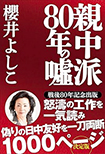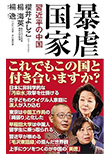The Imperial Household Agency Is Committing A Folly by Simplifying Imperial Rites
The prolonged hospital stay of Emperor Akihito, hospitalized on November 6 for treatment of bronchitis, is a matter of national concern. Issues pertaining to the health of the Emperor and Empress who are no longer as youthful as they once were, are extremely important for the nation. When contemplating the future of the imperial family and Japan, there are two points in particular which must be carefully considered.
The first point involves a review of the official duties of the 78-year-old Emperor.
On October 20, her 77th birthday, Empress Michiko spoke of the health of the imperial couple in a prepared statement answering questions from the press, in which she noted she and the emperor realize they are “entering a slightly more ‘uphill age,’” indicating it is a little more difficult to do what they used to do. On the day the Emperor was hospitalized with a fever, the Imperial Household Agency described his condition as “a case of accumulated fatigue and a decline in his powers of resistance.” Almost all Japanese are concerned about the Emperor’s health in view of his extraordinarily heavy schedule, especially after the Great East Japan Earthquake of March 11.
The Herculean effort made by the imperial couple starting immediately after the calamity, visiting the disaster-hit regions to encourage and cheer up the residents, consoled the entire nation and gave us the courage to once again undauntedly face the future. All Japanese are sincerely grateful for contributions made by the imperial couple towards unifying the country and beginning the task of reconstruction.
Describing the devastation of March 11 as an instance of “extreme absurdities” that “can never be accepted easily,” the Empress remarked:“Initially I had to face and overcome the hopelessness and helplessness that tended to overwhelm me. When I accompanied His Majesty and visited the three Tohoku prefectures to offer our sympathies, I was filled with anxiety, unsure whether I was up to the task of comforting the people. However, as the firm conviction of His Majesty was very clear to me 窶錀 that at a time like this, it was His role to visit the suffering people and to be with them 窶錀 I had no hesitation in accompanying Him.”
The imperial couple has indeed covered all the three prefectures devastated by the quake, calling on the victims at various temporary evacuation centers, speaking compassionately to them and cheering them up. What drove them to such action undoubtedly was their commitment to performing their imperial duties on behalf of the people as earnestly as possible. However, the more earnest they are, the more physically demanding it naturally gets.
The Emperor Alone Can Fill the People’s Spiritual Needs
Empress Michiko concluded her birthday statement by noting:“While valuing His Majesty’s wish to serve the people, I feel that we must heed the advice of the physicians and other people around Him and make sure that He is not overtired, and I hope that I, at His side, can always be attentive to His Majesty’s condition.” I strongly believe it is also we the people and the government that must “be attentive to” the emperor’s condition.
(Note from the editor:Emperor Akihito, who was released from hospital on November 24 after being treated for a high fever and mild bronchial pneumonia, has since been staying away from his official duties while recuperating at his palace residence, according to a palace spokesman.)
It is to be expected that the Emperor’s official duties will be prioritized in order to help lessen his burden. However, this must be done while not adversely affecting the more traditional duties also performed by the Emperor. Effective February 2008, the Imperial Household Agency took steps to reduce the Emperor’s duties by simplifying the many important Shinto rituals he regularly conducts at the Imperial Palace in Tokyo. The agency has recently announced it will “shorten the time spent by the Emperor on the November 23 ‘Niiname-sai’ ceremony,” which requires him to frequently stand and then sit for long periods on the floor in the formal “seiza” style, with back straight and knees together. (The ceremony, during which the Emperor offers new crops to thank the ancestral and other gods, is the most important of all the annual ritual ceremonies at the palace.)
The agency’s policy is mistaken. Shinto rituals constitute the basis of the existence of the imperial family. That the imperial family’s role is to pray for the peace and wellbeing of the nation and the people is stipulated in the Kinpi-sho (Rules of the Imperial Palace) written in 1221 by Emperor Juntoku (1197-1242), which plainly states: “The Shinto rites must always come first in the rules of etiquette at the palace, to be followed by other matters. Let there be no negligence in the Emperor’s heart and mind to honor the gods.”
In the centuries-old history of the imperial family, each successive emperor has strictly conducted Shinto rituals as his most important role, attending to other matters only afterwards. It was 窶錀 and still is and should be 窶錀 the role of the Emperor to worship the gods, praying for their divine protection so the peace of the nation and people will be secured. This great task is entrusted only to the Emperor.
The incumbent Emperor, similar to his 124 predecessors, has attached particularly great importance to conducting Shinto rituals, as he firmly considers it his role to pray to bring peace to the people of Japan.
According to Professor Sadasumi Mori, professor at the Shinto Culture Department of Kokugaku-in University in Tokyo, the rituals the Emperor conducts or attends are basically broken down into three categories 窶錀 the “Taisai” grand festivals in which the Emperor himself performs the rites and presents the “go-kohmon” message to his ancestors;the “Shosai” small-scale festivals in which the chief officer of court ceremony with the Imperial Household Agency performs the rituals, with the Emperor only offering prayers; and other rites. (Lingering Crisis of the Imperial Succession , co-authored by Sadasumi Mogi, Yasuo Ohara, and Yoshiko Sakurai. Fuso-sha, Tokyo;October 2009)
It is said that there are over 30 stringent rituals that have been annually performed at the palace since ancient times in which the Emperor himself is required to be properly attired in time-honored costumes. On these occasions, the Emperor must rise in the wee hours, even in the bitter cold of winter, and purify himself for the ritual.
It is assumed that Empress Michiko, also rising early and purifying herself in the same way as Emperor Akihito, sits through the rites while watching him back in the palace with all her heart as he conducts the ritual at one of the three inner sanctuaries within the imperial palace.
A ritual that is particularly important is the “Shiho-hai,” conducted early on January 1. The first ceremony of the year, the Emperor offers prayers of peace to all of the gods “in all four directions” (“shiho”), starting with the distant gods of Ise Shrine. This ritual has special significance, as the Emperor prays for the peace and wellbeing of the nation. He alone is to conduct this ritual, and nobody else is allowed to act as his proxy. This important ceremony is followed by a number of similarly important rituals, including: the “Genshi-sai” on January 3 celebrating the origin of the Imperial Throne;the “Sentei-sai” on January 7 to honor the late Emperor Showa;the ”Shinki-shinden-sai” on the spring equinox day to honor and thank ancestors;the “Jinmu-tenno-sai” on April 3 marking the passing of the legendary first emperor of Japan;the “Shuki-korei-sai” in September honoring ancestors on the autumn equinox day;the “Kanname-sai” on October 17 to offer new crops to the gods as thanks;and the “Niiname-sai” on November 23.
The Folly of Simplifying Rituals at the Palace
As earlier mentioned, there are numerous other rituals in addition to these major ones. The Emperor performs or attends these rituals between all his numerous official duties, including visits to local villages, cities, and towns; receiving and often entertaining foreign dignitaries; and putting his signature on documents previously approved by the cabinet.
Under the US occupation following the end of World War II, the basis of Japan as a nation that reflected Japanese tradition and values was forced to be thoroughly changed, including the constitution and the Imperial Household Law. Particularly ruthless was the decision by GHQ (General Headquarters of the Supreme Commander of the Allied Powers) to trivialize as the private activity of the Imperial family the assortment of traditional Shinto rituals which the imperial family performed on behalf of the nation and people throughout Japanese history.
The Emperor’s post-war official duties have been limited to merely signing documents and visiting local villages, towns, and cities across the country, with the varied rituals he performs or attends defined as something he does for his private needs. This unpardonable decision on the part of GHQ, which has deprived Japan of a fundamental element of its national character, has unfortunately taken root in post-war Japan, absurd thought it is. That is why the Imperial Household Agency, in the name of reducing the Emperor’s burden, is so quick to move in the direction of simplifying these extremely important Shinto rituals.
This “solution” by the agency, which is nothing but putting the horse before the cart, embraces the danger of denying the unique characteristics of the imperial family, transforming it into a totally different entity absolutely incompatible with Japanese history. It is time to recall the importance of “Shinto rituals first, and other matters later,” as Emperor Juntoku wrote nearly eight centuries ago. The agency should take measures to reduce the burden on the Emperor in the realm of “other matters” by meting out some of his duties to Crown Prince Naruhito and Crown Princess Masako, Prince Akishino and his wife Princess Kiko, as well as other members of the imperial family. That, I believe, is a logical part of the responsibilities they should bear in the first place.
The second important point to tackle in view of the Emperor’s illness is the need to revise the Imperial Household Law of 1947. Although the family of Prince Akishino has five-year-old Prince Hisahito, third in line to the throne, there may be no other imperial family members left by the time Prince Hisahito ascends to the throne if the status quo is maintained within the imperial family. As is generally known, female members of the family, when they marry, automatically lose their membership under the principle of agnatic succession specified in the Imperial Household Law. It is a situation that naturally makes one feel quite uneasy about the future of the imperial family. That is all the more reason why revision of the Imperial Household Law must be expedited.
(Translated from “Renaissance Japan” column no. 487 in the December 1, 2011 issue of The Weekly Shincho.)















